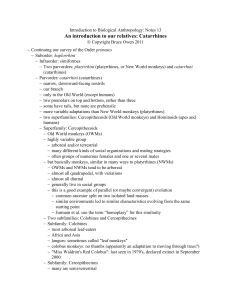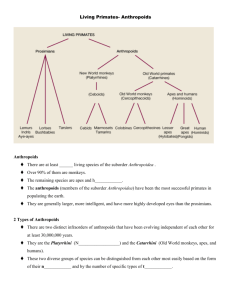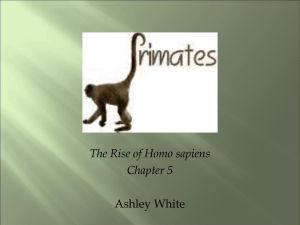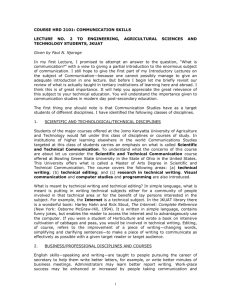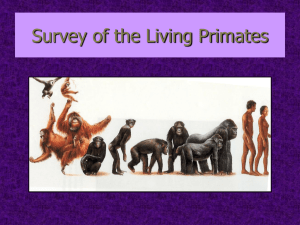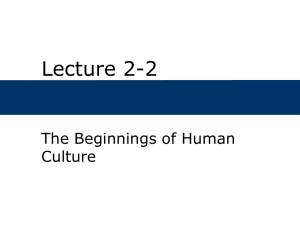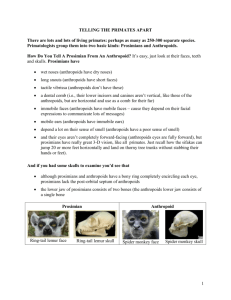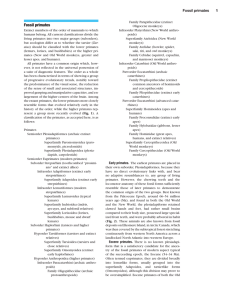Chapter 17 Lecture notes
advertisement
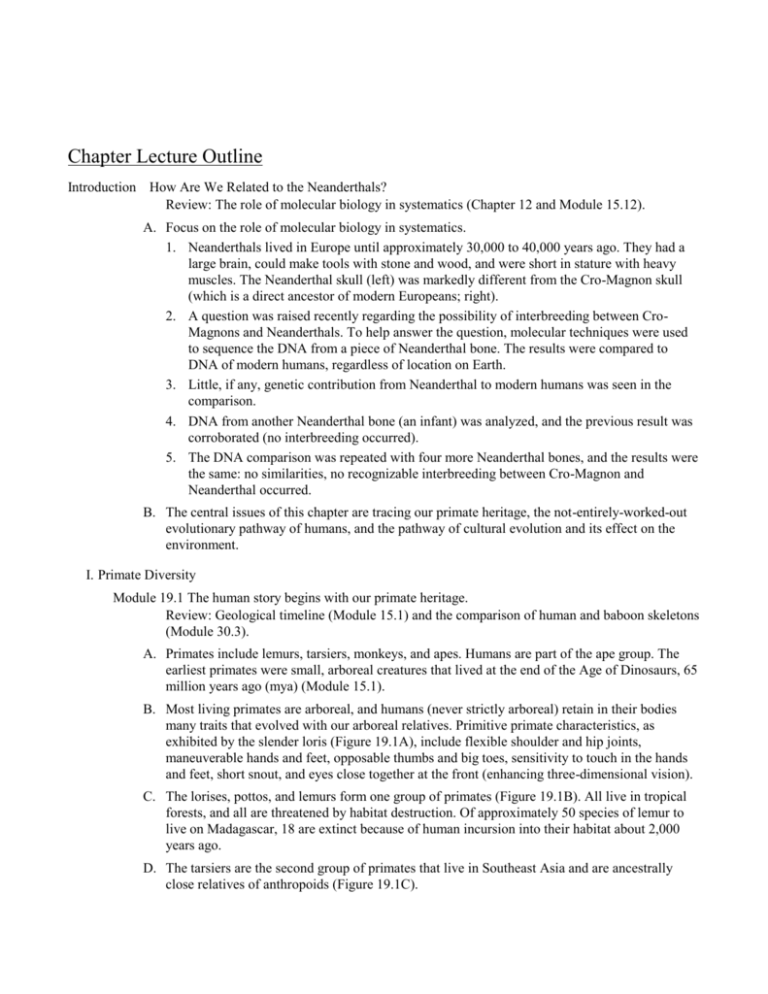
Chapter Lecture Outline Introduction How Are We Related to the Neanderthals? Review: The role of molecular biology in systematics (Chapter 12 and Module 15.12). A. Focus on the role of molecular biology in systematics. 1. Neanderthals lived in Europe until approximately 30,000 to 40,000 years ago. They had a large brain, could make tools with stone and wood, and were short in stature with heavy muscles. The Neanderthal skull (left) was markedly different from the Cro-Magnon skull (which is a direct ancestor of modern Europeans; right). 2. A question was raised recently regarding the possibility of interbreeding between CroMagnons and Neanderthals. To help answer the question, molecular techniques were used to sequence the DNA from a piece of Neanderthal bone. The results were compared to DNA of modern humans, regardless of location on Earth. 3. Little, if any, genetic contribution from Neanderthal to modern humans was seen in the comparison. 4. DNA from another Neanderthal bone (an infant) was analyzed, and the previous result was corroborated (no interbreeding occurred). 5. The DNA comparison was repeated with four more Neanderthal bones, and the results were the same: no similarities, no recognizable interbreeding between Cro-Magnon and Neanderthal occurred. B. The central issues of this chapter are tracing our primate heritage, the not-entirely-worked-out evolutionary pathway of humans, and the pathway of cultural evolution and its effect on the environment. I. Primate Diversity Module 19.1 The human story begins with our primate heritage. Review: Geological timeline (Module 15.1) and the comparison of human and baboon skeletons (Module 30.3). A. Primates include lemurs, tarsiers, monkeys, and apes. Humans are part of the ape group. The earliest primates were small, arboreal creatures that lived at the end of the Age of Dinosaurs, 65 million years ago (mya) (Module 15.1). B. Most living primates are arboreal, and humans (never strictly arboreal) retain in their bodies many traits that evolved with our arboreal relatives. Primitive primate characteristics, as exhibited by the slender loris (Figure 19.1A), include flexible shoulder and hip joints, maneuverable hands and feet, opposable thumbs and big toes, sensitivity to touch in the hands and feet, short snout, and eyes close together at the front (enhancing three-dimensional vision). C. The lorises, pottos, and lemurs form one group of primates (Figure 19.1B). All live in tropical forests, and all are threatened by habitat destruction. Of approximately 50 species of lemur to live on Madagascar, 18 are extinct because of human incursion into their habitat about 2,000 years ago. D. The tarsiers are the second group of primates that live in Southeast Asia and are ancestrally close relatives of anthropoids (Figure 19.1C). E. The anthropoids include monkeys, apes, and humans. Anthropoids differ from the other two groups in having relatively larger brains and depending more on eyesight than on smell. Anthropoids have a fully opposable thumb, though the human thumb is designed less for power and more for manipulation. Anthropoids began diverging from other primates about 50 mya. F. Monkeys differ from apes and humans in having a tail and equal-length forelimbs and hind limbs. They originated in Africa and migrated to other countries in Asia and the Americas. New World monkeys have nostrils that are wide open and far apart, and they often have prehensile tails (Figure 19.1E). G. The phylogenetic tree of primates indicates several interesting possibilities (Figure 19.1D). 1. Anthropoids diverged from other primates around 50 mya. 2. Old World monkeys and New World monkeys diverged onto separate paths about 30 mya. 3. Apes evolved from Old World monkeys around 20–25 mya. 4. Humans diverged from an ancestor of chimpanzees approximately 5–7 mya. H. Old World monkeys can be recognized by their narrow, close-set nostrils; many have a tough seat pad; and if a tail is present, it is not prehensile (Figure 19.1F). Module 19.2 Hominoids include humans and four other groups of apes. A. Primates (also called apes) include gibbons, orangutans, gorillas, chimpanzees, bonobos, and humans. All are tropical, lack tails, have longer forelimbs than hind limbs, have relatively large brains, and—apart from humans—have a limited geographical range. This group is formally referred to as hominoids. Review: Figure 15.9C illustrates a relationship between humans and apes based on molecular data. B. Gibbons are the only apes that are entirely arboreal and monogamous for life. Nine species are found in Southeast Asia (Figure 19.2A). C. The orangutan is a shy, solitary ape that is mostly arboreal, living in forests in Sumatra and Borneo (Figure 19.2B). D. The gorilla is the largest of all primates and spends most of its time on the ground in African rain forests (Figure 19.2C). When they walk, their knuckles touch the ground. E. The chimpanzee (and the very similar bonobo) inhabits rain forests in central Africa. Like gorillas, chimpanzees and bonobos are knuckle walkers. Many aspects of chimpanzee behavior resemble human behavior. They are fully capable of innovative behavior, can learn human sign language, and very likely have complex self-awareness. Recent biochemical evidence shows that chimpanzees and humans share 99% of their DNA sequences (Figure 19.2D). Preview: In Module 35.19, Jane Goodall discusses dominance hierarchies and cognition in chimpanzees. NOTE: Consider how different the classification of humans and chimpanzees might be were humans not doing the classifying, or how the classification scheme might differ if two nonhuman species exhibiting the same evolutionarily close relationship were being considered. II. Hominid Evolution Module 19.3 The human branch of the primate tree is only a few million years old. A. Hominids diverged evolutionarily from a common ancestor, probably about 5–7 mya (Figure 19.1D). B. The study of human evolution is called paleoanthropology. Three words not to confuse are hominids (human species), hominoids (apes and humans), and anthropoids (apes, humans, and monkeys). C. Five major characteristics distinguishing humans from other hominoids are as follows: 1. Larger brain size, capable of language and symbolic thought, and make and use complex tools. 2. Shorter jaws and flatter faces. 3. Bipedal posture and upright position. 4. Long-term pair bonding between mates. 5. Extended child care. NOTE: Emphasize that humans did not descend from apes but, instead, share a recent common ancestor with apes (chimpanzees). D. There are several different species (and several genera) in the human lineage. Evolutionary connections among the species illustrated (and others not illustrated) are hotly debated. The figure shows when each species lived (as determined from the known fossil record) but does not join them in a phylogenetic tree (Figure 19.3). It is only a time line. E. Hominid diversity increased dramatically between 4 and 2 mya. The Australopithecus anamensis (4–4.5 mya) showed leg bones that were increasingly bipedal. Many of the early hominids are collectively called australopiths; however, this does not imply a monophyletic group. F. Homo sapiens (that’s us) is the only extant hominid. A common misconception is that humans evolved in direct lineage from an ancestor that separated from the apes and went directly to Homo sapiens. There were many dead ends along the way. Module 19.4 Upright posture evolved well before an enlarged brain in hominids. A. In what is now Tanzania, footprints left by Australopithecus afarensis indicate that hominids have been bipedal for at least 3.5 million years (Figure 19.4). B. An important clue to bipedalism is the position of the skull in relationship to the spinal cord exit. The exit is at the base of the skull, allowing an upright position. C. One of the most complete fossils of an australopith, nicknamed Lucy (Figure 19.4), dates back to 3.24 million years ago. A. afarensis was a small-brained (and small in stature) bipedal hominid that lived for about one million years. D. What was the selective pressure that led to bipedalism? Was it an increase in the savanna or a way to reach low-hanging fruit from the ground? Irrespective of the reason, the hands of the early hominids were freed for other uses, such as tool production. Regardless, brain enlargement was preceded by bipedalism. Module 19.5 Homo—the evolution of larger brains and reduced sexual dimorphism. A. Brain enlargement was first evident in fossils from East Africa dated at around 2.4 mya. The larger skull also had a shorter jaw and was associated with stone tools. Thus the fossil has been assigned to the species Homo habilis (“handy man”). B. A fossil that dates back to 1.9 to 1.6 mya was discovered and is called H. ergaster. The brain size was much larger than H. habilis, its legs and hips were well designed for walking long distances, and the difference between the sizes of the sexes was less prominent (see Module 13.17, sexual dimorphism). Reduction in sexual dimorphism is often associated with pairbonding (perhaps monogamy) and shared child-raising responsibility. C. The teeth of H. ergaster were smaller, indicating a change in eating habits (more meat and less plant material) or perhaps some food preparation. More sophisticated tools were also used by H. ergaster. D. H. erectus (“upright man”) lived from about 1.8 mya to 250,000 years ago. H. erectus was taller and had a larger brain and a more advanced culture than H. habilis. H. erectus lived in huts or caves, built fires, wore clothes, and made more complex tools. E. H. erectus spread out of Africa to Eurasia. With its broad geographic distribution, H. erectus became regionally diverse. One or more populations probably gave rise to our own species, Homo sapiens. Review: Chapter 14 discusses geographic patterns of speciation. Module 19.6 When and where did modern Homo sapiens arise? A. Evidence from fossil records and from DNA analysis indicates that all living Homo sapiens originated from Africa. B. Ancestors of humans also came from Africa and date back as far as 600,000 years ago. The oldest fossil of H. sapiens found in Ethiopia dates back to 160,000 years (Figure 19.6A). C. DNA studies indicate that Asians and Europeans are more closely related and that many African lineages represent earlier branches on the human family tree. This strongly suggests that all living humans have ancestors that originated as H. sapiens in Africa. D. The conclusion regarding the origin of H. sapiens from Africa is further supported by the data from mitochondrial DNA and Y-chromosome analysis. Mitochondrial DNA analysis suggests that we all came from a “woman” that lived approximately 150,000 years ago. Y-chromosome analysis also suggests divergence from a common ancestor less than 100,000 years ago. E. Evidence suggests that humans left Africa more than once, spreading to Asia first, then to Europe and Australia (oldest fossil outside Africa is approximately 50,000 years old). Arrival in the Americas is not certain but may have been between 30,000 and 15,000 years ago. F. The rapid expansion of humans may have been related to their creativity and increased cognition. Neanderthal was a good tool-maker but showed little creativity or symbolic thought. Art from humans dates back to 77,000 years ago (Figure 19.6B). G. Advanced thinking may have increased reproductive fitness, and other hominids could not compete when encountering humans. A good example of this is the extinction of the Neanderthal in Europe. Module 19.7 Connection: Human skin colors reflect adaptation to varying amounts of sunlight. A. Skin color of early hominids was probably similar to chimpanzees, light and covered with hair. As the early species (e.g., H. ergaster) evolved and began walking longer distances, less hair was an advantage when trying to stay cool. Damage from overexposure to UV radiation leading to skin cancer happened after reproductive age; thus this was not a selective factor for darker skin. B. Folate (folic acid) is destroyed by UV. Therefore darker skin would be a positive selection factor to protect folate, which is needed during fetal development. UV also promotes calcium absorption, which is also needed for fetal development. In the intense sun of Africa, enough calcium would be absorbed even with dark skin. In other climates with less sun (northern latitudes), light skin would be more adaptive. Module 19.8 Connection: A genetic difference helped humans start speaking. A. The adaptation to speak and communicate with one another is one of the human characteristics that may have helped the global spread of humans (Figure 19.8). B. A gene called FOXP2 has been shown to be critical for brain development. The species with the closest DNA sequence to our FOXP2 gene are birds. Like birds that learn their song from other birds, humans teach their young to speak. C. Molecular evidence indicates that the FOXP2 gene arose about 100,000 years ago, which coincides with the early fossils of H. sapiens. D. Other genes are involved in speech, such as those used to shape proper anatomy and brain function. But researchers think that FOXP2 is the critical gene for linguistics, which binds us together. This capacity to communicate allows the older members of human society to pass on large amounts of information to the next generation. Language is the basis of civilization. III. Our Cultural History and Its Consequences Module 19.9 Culture gives humans enormous power to change the environment. Preview: Human population growth (Module 36.9), the impact of outside disturbances on community structure (Module 37.7), and the sociobiology of culture (Modules 35.15 and 35.19). A. Three milestones highlight human evolution: 1. Erect stance, requiring skeletal remodeling. 2. Brain enlargement, with prolonged post-birth development of the skull and its contents. 3. Evolution of a prolonged childhood, during which cultural information is passed between generations (Module 15.7). B. The upright stance limits the pelvic opening, creating a problem during childbirth due to the overly large heads of babies. C. Culture includes the accumulated knowledge, customs, beliefs, arts, crafts, and ideas that are passed between generations. More than any other human feature, our culture can change the environment to meet our (selfish) needs at a faster rate than biological evolution. Our culture has allowed our species to transcend the limitations imposed on other species at the expense of other species and the environment. Preview: Population dynamics is discussed in Chapter 36. The impact of human culture on the environment is discussed in Chapter 38. Module 19.10 Scavenging, gathering, and hunting were the earliest human endeavors. A. This way of life began with the earliest hominids and continued to be the way of life for the australopiths and species of Homo until about 100,000 years ago. Hunting became important only with the advent of sophisticated tools 50,000 years ago. B. Some extant cultures (e.g., the !Kung of southwestern Africa) still practice hunting-gathering (Figure 19.10). C. With the development of more sophisticated hunting tools comes evidence of human-caused decimation of species such as the woolly rhinoceroses and giant deer of Europe. D. Humans reached Australia about 50,000 years ago, an event that may have been responsible for the extinction of the giant kangaroos. E. Nomadic hunters migrated from Asia to North America about 30,000 years ago. Their actions are likely to have caused the extinction of many large animal species. F. Other characteristics of this level of culture include the organization into communal groups that divided labor, the use of semipermanent homes, trading among populations, and (toward the end of the period) the growing of a few simple crops. Module 19.11 Agriculture was a major development in human history. A. Agriculture developed in Africa, Eurasia, and the Americas 10,000 to 15,000 years ago. Forests were cleared and crops were planted with little damage done to the soil. Review: The effects of deforestation on tropical forests are discussed in Module 34.18. B. About 5,000 years ago, farmers started using primitive plows (Figure 19.11). This opened up new areas for agriculture and increased productivity. Increases in population size made possible by improved agriculture, and the use of more advanced plows and overgrazing, and climate changes turned the Fertile Crescent from a rich forest area into a desert. Review: Runoff from the overuse of fertilizers can result in algal blooms (Module 16.13). Also review soil conservation (Module 32.9) and organic farming (Module 32.10). C. Agriculture changed forever the relationship between humans and the biosphere. Large areas of native vegetation have been converted to farming use. Agriculture allows the establishment of permanent settlements and cities, and it frees many members of cultures to specialize in other activities (such as teaching college courses). Module 19.12 Development of complex tools impacts human culture and the world. Preview: Human population growth (Modules 36.9–36.10). A. The change from small hand tools to large-scale machines produced major effects on most human activities (Figure 19.12). NOTE: The first industries built up around the fabrication of metal tools for hunting and farming long before the machine age. B. Complex machines further reduced the need for agricultural workers. Energy consumption increased. Medical advances reduced deaths. C. During all these cultural changes, humans have not changed genetically in any significant way. Rapid cultural change has changed environments in which humans and other species live. Nothing is new about this environmental change except the speed of the change, which now vastly outpaces the rate of biological evolution. Preview: The effects of human interaction on the environment will be discussed in Chapter 38.

